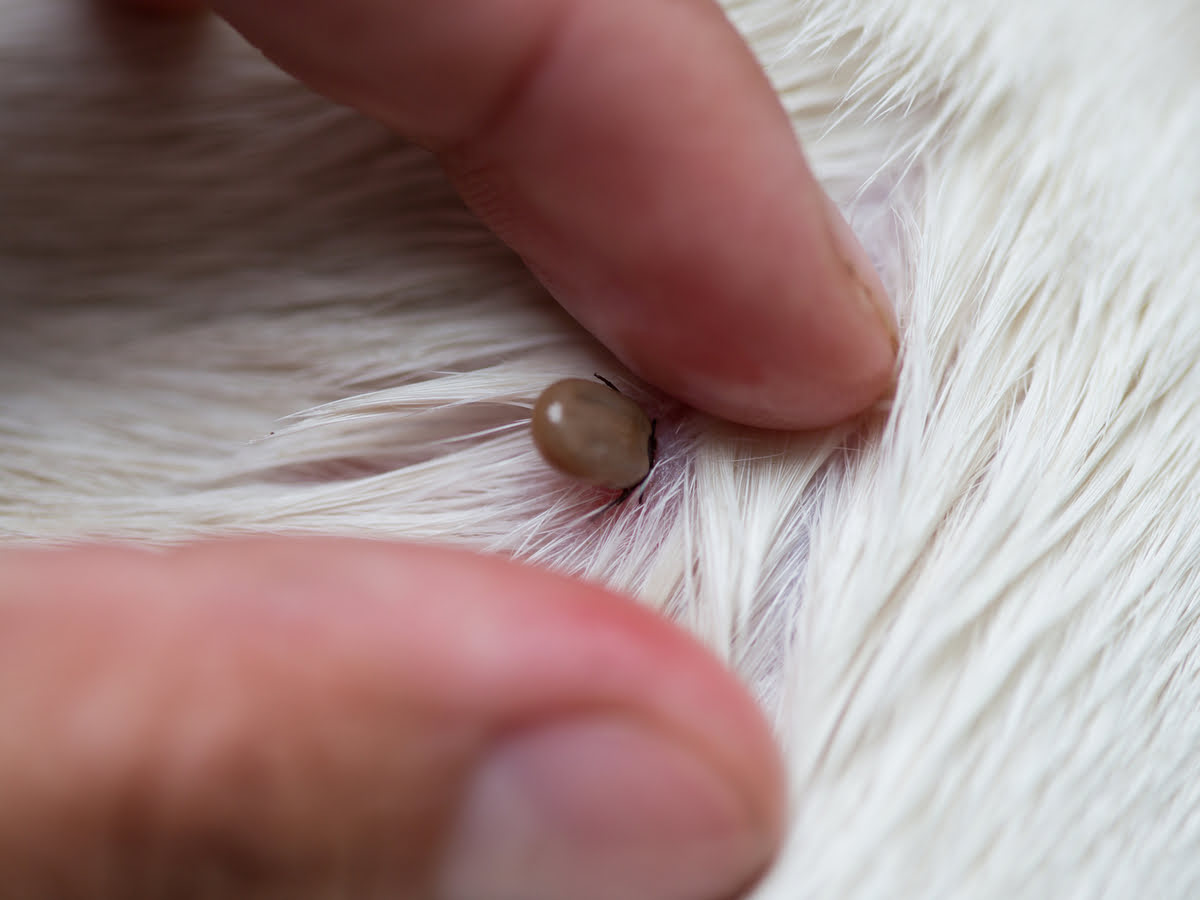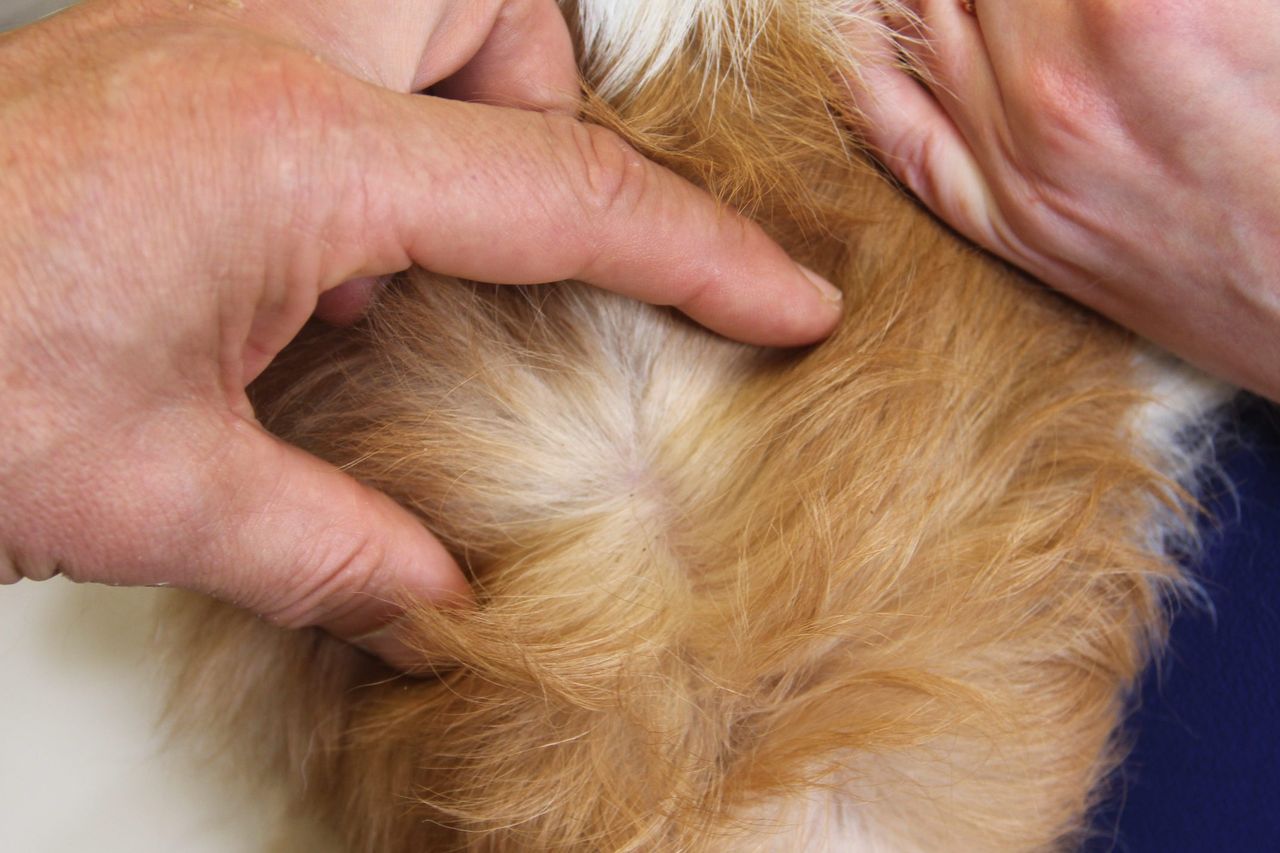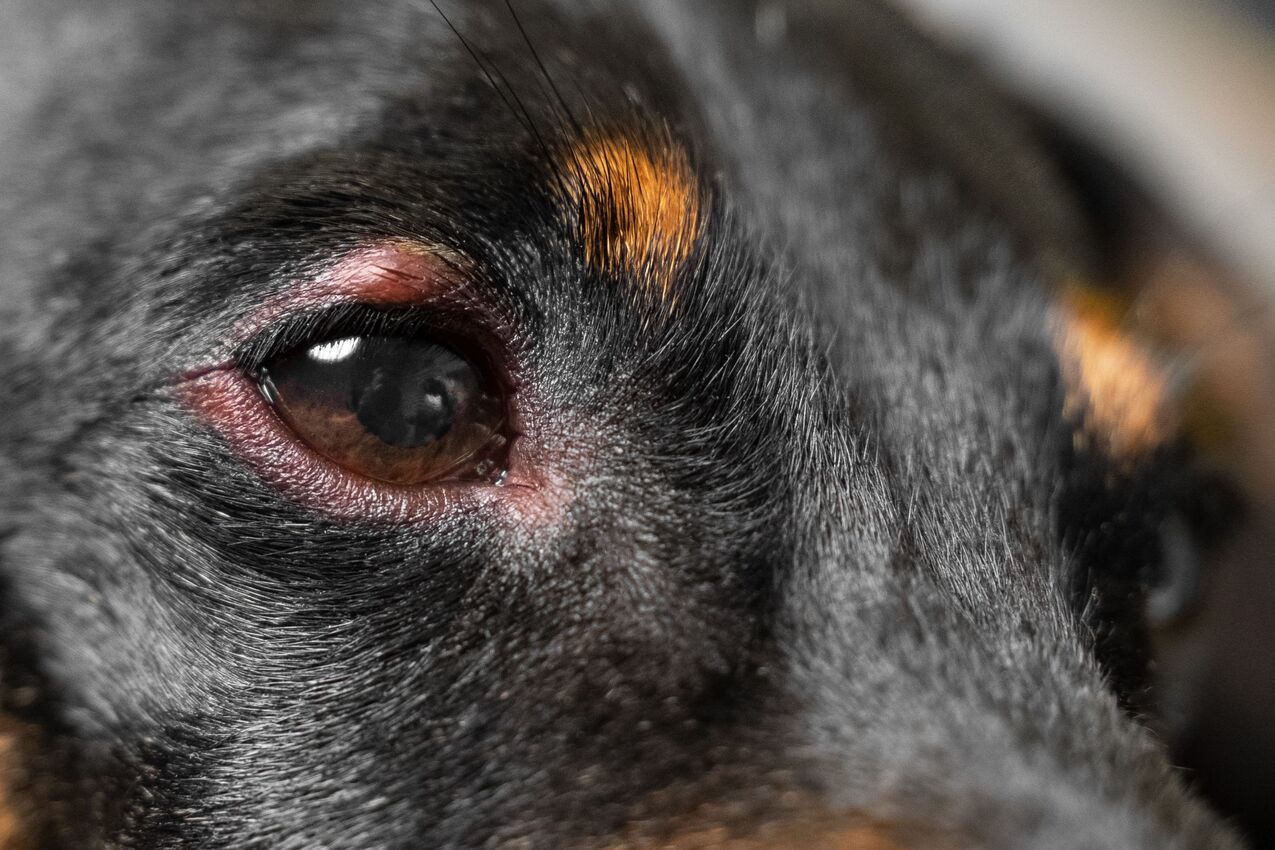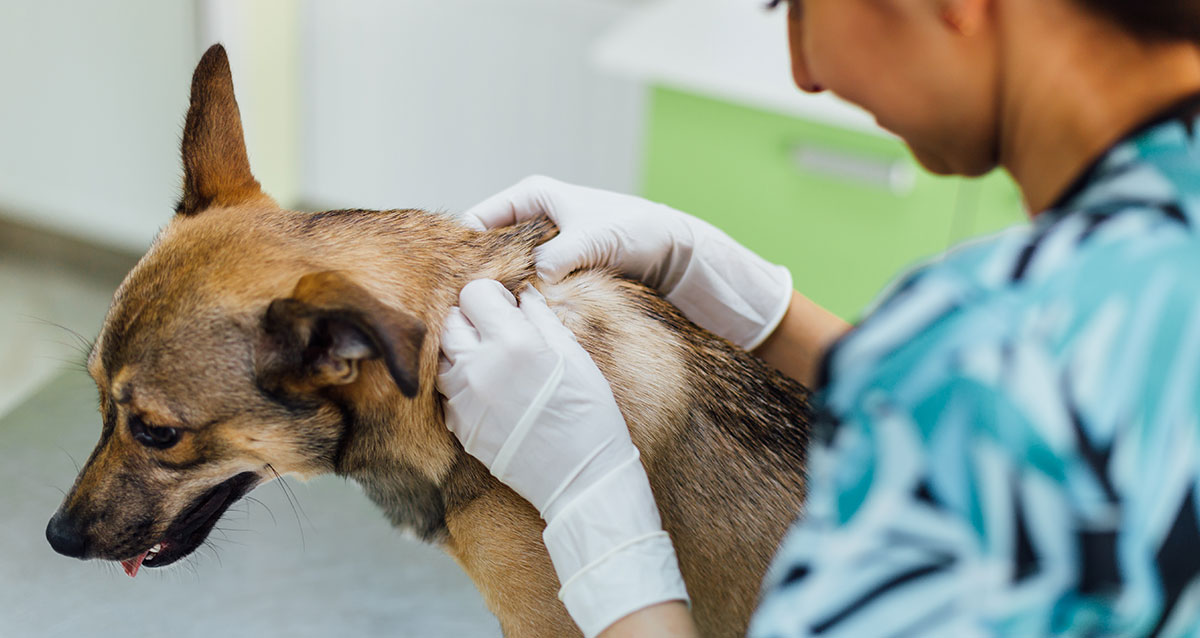Home>Health & Wellness>Common Health Issues>What Can A Tick Do To A Dog


Common Health Issues
What Can A Tick Do To A Dog
Modified: February 21, 2024
Learn about common health issues in dogs caused by ticks and how to protect your furry friend from these dangers. Understand the risks and prevention methods.
(Many of the links in this article redirect to a specific reviewed product. Your purchase of these products through affiliate links helps to generate commission for Pawsomeoldies.com, at no extra cost. Learn more)
Table of Contents
Introduction
Ticks are tiny, blood-sucking parasites that pose a significant threat to the health and well-being of dogs. These minuscule creatures may seem inconspicuous, but their impact can be devastating. As a responsible pet owner, it's crucial to understand the potential dangers that ticks present and take proactive measures to protect your furry companion.
When a tick latches onto a dog, it can transmit a variety of harmful pathogens, including bacteria, viruses, and parasites. These insidious hitchhikers are capable of causing a range of debilitating illnesses, some of which can be life-threatening if left untreated. Therefore, it's essential to be vigilant and proactive in preventing tick infestations and promptly addressing any signs of tick-borne diseases in dogs.
In this comprehensive guide, we will delve into the various aspects of tick-borne diseases in dogs, including the common health issues they can cause, the signs and symptoms to watch out for, and the best practices for prevention and treatment. By gaining a deeper understanding of these topics, you'll be better equipped to safeguard your canine companion from the perils of tick-borne illnesses.
Throughout this article, we will explore the specific diseases that ticks can transmit to dogs, shedding light on the potential consequences of these infections. Additionally, we will discuss the importance of implementing effective tick prevention strategies and the available treatment options for addressing tick infestations and the associated diseases.
As we embark on this enlightening journey, it's important to approach the topic with a sense of urgency and responsibility. By staying informed and proactive, we can work together to ensure the well-being and vitality of our beloved canine friends, protecting them from the harmful effects of tick-borne diseases.
Read more: What Shot Can My Dog Get For Ticks
Understanding Ticks and Their Dangers
Ticks are small, arachnid parasites that feed on the blood of animals, including dogs. These ectoparasites are commonly found in outdoor environments, particularly in grassy, wooded, and humid areas. When a tick attaches itself to a dog, it can pose significant dangers to the animal's health.
One of the primary dangers associated with ticks is their ability to transmit various disease-causing pathogens. Ticks can harbor bacteria, viruses, and parasites, and when they bite a dog to feed on its blood, these harmful microorganisms can be transferred into the dog's bloodstream. This transmission of pathogens can lead to the development of serious illnesses, ranging from mild to severe, and in some cases, even life-threatening conditions.
Furthermore, ticks are adept at concealing themselves on a dog's body, making them challenging to detect. These parasites often attach themselves in hidden areas such as the ears, between the toes, and under the tail, making it difficult for pet owners to notice their presence. As a result, dogs can become unwitting hosts to these insidious parasites, allowing them to feed and potentially transmit diseases without immediate detection.
In addition to the direct health risks they pose, ticks can also cause discomfort and irritation to dogs. When a tick attaches itself and begins feeding, it injects saliva that contains anticoagulants to prevent the host's blood from clotting. This process can lead to localized inflammation, itching, and discomfort for the affected dog.
Understanding the dangers posed by ticks is crucial for pet owners, as it underscores the importance of implementing effective preventive measures. By recognizing the potential threats associated with tick infestations, dog owners can take proactive steps to protect their pets from these harmful parasites and the diseases they may carry.
In summary, ticks present a multifaceted danger to dogs, encompassing the transmission of disease-causing pathogens, the challenge of detection, and the potential for discomfort and irritation. By gaining a comprehensive understanding of these dangers, pet owners can prioritize tick prevention and safeguard their canine companions from the perils associated with tick-borne illnesses.
Common Diseases Transmitted by Ticks
Ticks are notorious vectors for a variety of diseases that can have detrimental effects on dogs. These tiny parasites can transmit a range of pathogens, including bacteria, viruses, and parasites, leading to the development of serious illnesses in canine companions. Understanding the common diseases transmitted by ticks is essential for pet owners to recognize the potential health risks and take proactive measures to protect their dogs.
Lyme Disease
Lyme disease, caused by the bacterium Borrelia burgdorferi, is one of the most well-known tick-borne illnesses in dogs. When an infected tick bites a dog, it can transmit the bacteria, leading to symptoms such as lameness, joint swelling, fever, lethargy, and decreased appetite. If left untreated, Lyme disease can progress to more severe complications, affecting the heart, kidneys, and nervous system.
Ehrlichiosis
Ehrlichiosis is a bacterial disease transmitted by the brown dog tick, the lone star tick, and the American dog tick. This condition can manifest in acute, subclinical, and chronic phases, with symptoms including fever, lethargy, anemia, and bleeding disorders. In severe cases, ehrlichiosis can cause organ damage and even be fatal if not promptly addressed.
Read more: What Can Be Used To Keep Ticks Off Dogs
Anaplasmosis
Anaplasmosis is caused by the bacterium Anaplasma phagocytophilum and is transmitted by the black-legged tick and the western black-legged tick. Dogs infected with anaplasmosis may experience symptoms such as lameness, joint pain, fever, lethargy, and decreased appetite. In some cases, the disease can lead to severe complications affecting the blood, joints, and organs.
Rocky Mountain Spotted Fever
Rocky Mountain spotted fever is a potentially severe illness caused by the bacterium Rickettsia rickettsii, which is transmitted by the American dog tick, the Rocky Mountain wood tick, and the brown dog tick. Dogs with Rocky Mountain spotted fever may display symptoms such as fever, lethargy, joint pain, neurological abnormalities, and skin lesions. Without timely intervention, this disease can have life-threatening consequences.
Babesiosis
Babesiosis is a protozoal disease transmitted by the brown dog tick, the American dog tick, and the lone star tick. This condition can lead to symptoms such as fever, weakness, pale gums, and anemia. In severe cases, babesiosis can cause organ failure and be life-threatening, particularly for dogs with compromised immune systems.
Preventing Tick-Borne Diseases
Given the serious nature of these tick-borne diseases, prevention is paramount. Implementing effective tick control measures, such as using veterinarian-recommended tick preventatives, regularly checking dogs for ticks after outdoor activities, and minimizing exposure to tick-infested areas, can significantly reduce the risk of tick-borne illnesses.
By understanding the common diseases transmitted by ticks and the potential consequences they pose, pet owners can prioritize proactive measures to protect their dogs from these harmful pathogens. Through vigilance, education, and preventive strategies, the impact of tick-borne diseases on canine health can be mitigated, ensuring the well-being and vitality of beloved furry companions.
Read more: What Can I Spray On My Dogs To Repel Ticks
Signs and Symptoms of Tick-Borne Diseases in Dogs
Tick-borne diseases can manifest in a variety of symptoms, and recognizing these signs is crucial for early detection and intervention. While the specific symptoms may vary depending on the type of disease and the individual dog's immune response, there are several common indicators that pet owners should be vigilant about.
One of the primary signs of tick-borne diseases in dogs is lameness or reluctance to move. Dogs may exhibit stiffness, joint pain, or an overall reluctance to engage in physical activity. This can be indicative of conditions such as Lyme disease, ehrlichiosis, or anaplasmosis, all of which can affect the musculoskeletal system and lead to mobility issues.
Fever is another prevalent symptom of tick-borne diseases in dogs. An unexplained elevation in body temperature, often accompanied by lethargy and decreased appetite, can signal the presence of an underlying infection. Monitoring a dog's temperature and seeking veterinary attention if persistent fever occurs is essential for timely diagnosis and treatment.
Changes in behavior and overall demeanor can also be indicative of tick-borne illnesses. Dogs may appear unusually lethargic, withdrawn, or irritable, displaying a departure from their typical temperament. Additionally, neurological symptoms such as disorientation, seizures, or abnormal gait may manifest in certain tick-borne diseases, signaling potential involvement of the central nervous system.
Furthermore, symptoms such as pale gums, weakness, and decreased appetite can be indicative of anemia, a common consequence of tick-borne diseases such as babesiosis. Anemia can lead to weakness, fatigue, and reduced tolerance for physical exertion, impacting the overall well-being of the affected dog.
In some cases, dogs may develop skin lesions, bruising, or bleeding disorders as a result of tick-borne diseases, particularly those affecting the blood and circulatory system. These visible manifestations can serve as important indicators of underlying health issues and should prompt immediate veterinary evaluation.
It's important to note that the signs and symptoms of tick-borne diseases can overlap, making accurate diagnosis challenging without professional veterinary assessment. Therefore, if a dog exhibits any of the aforementioned symptoms or displays unexplained health changes, seeking prompt veterinary care is imperative for proper evaluation and treatment.
By remaining attentive to these potential signs and symptoms, pet owners can play a proactive role in safeguarding their dogs' health. Early recognition of these indicators can facilitate timely intervention, leading to improved outcomes and the effective management of tick-borne diseases in canine companions.
Prevention and Control of Ticks
Preventing and controlling tick infestations is paramount in safeguarding the health and well-being of dogs. By implementing comprehensive strategies to minimize the risk of tick exposure and infestation, pet owners can significantly reduce the likelihood of their canine companions contracting tick-borne diseases.
One of the most effective measures for tick prevention is the use of veterinarian-recommended tick preventatives. These products, which may include topical treatments, oral medications, or collars, are specifically formulated to repel and kill ticks, thereby providing a crucial line of defense against these parasitic pests. Regular application of tick preventatives, as directed by a veterinarian, can offer long-lasting protection and peace of mind for pet owners.
In addition to tick preventatives, environmental management plays a pivotal role in controlling tick populations. Keeping outdoor areas well-maintained by regularly mowing the lawn, trimming vegetation, and removing leaf litter can help reduce tick habitats. Creating a barrier of gravel or wood chips between lawns and wooded areas can also deter ticks from encroaching into frequented spaces.
Furthermore, performing routine tick checks on dogs after outdoor activities is essential for early detection and removal of any attached ticks. Thoroughly examining the dog's coat, paying close attention to hidden areas such as the ears, armpits, and between the toes, can help identify and promptly remove any ticks before they have a chance to transmit disease-causing pathogens.
Pet owners should also consider utilizing tick control measures in outdoor environments where dogs spend time. This may involve treating yards and outdoor spaces with environmentally safe tick control products, such as sprays or granules, to reduce the presence of ticks in the immediate vicinity. Additionally, minimizing outdoor excursions during peak tick activity periods, such as spring and summer, can help lower the risk of tick encounters.
Educating oneself about the geographical prevalence of ticks and the specific diseases they carry is crucial for informed prevention. Understanding regional tick patterns and prevalent diseases enables pet owners to tailor their preventive strategies accordingly, taking into account local environmental factors and disease risks.
By integrating these multifaceted approaches to tick prevention and control, pet owners can create a comprehensive defense against tick-borne diseases. Through a combination of veterinarian-recommended preventatives, environmental management, routine tick checks, and informed awareness, dogs can enjoy a reduced risk of tick infestations and the associated health hazards.
In summary, proactive tick prevention and control measures are essential components of responsible pet ownership, contributing to the overall health, comfort, and longevity of canine companions. By prioritizing these strategies, pet owners can create a safer and more enjoyable environment for their beloved dogs, free from the perils of tick-borne illnesses.
Treatment for Tick Infestations and Diseases
When a dog is affected by tick infestations or tick-borne diseases, prompt and effective treatment is essential to mitigate the impact on the animal's health. The approach to treatment may vary depending on the specific condition and its severity, but it generally encompasses several key components aimed at addressing both the infestation and the associated health complications.
Tick Infestations
For tick infestations, the primary focus of treatment involves the safe and thorough removal of the ticks from the dog's body. This process requires meticulous care to ensure that the ticks are completely extracted, minimizing the risk of disease transmission. Using fine-tipped tweezers, the ticks should be grasped as close to the skin's surface as possible and steadily pulled upward with gentle, even pressure. Twisting or jerking motions should be avoided to prevent leaving behind any tick mouthparts.
Following the removal of ticks, it is important to disinfect the affected area and monitor the dog for any signs of localized irritation or infection. Additionally, implementing preventive measures, such as using veterinarian-recommended tick preventatives and environmental management strategies, can help prevent future infestations.
Read more: What Can Dog Fleas Do To Humans
Tick-Borne Diseases
The treatment of tick-borne diseases in dogs typically involves a multifaceted approach tailored to the specific illness and its impact on the animal's health. Upon diagnosis of a tick-borne disease, veterinary intervention is crucial to initiate appropriate treatment protocols. This may include the administration of antibiotics, antiparasitic medications, anti-inflammatory drugs, and supportive care to address the symptoms and combat the underlying infection.
In cases of severe tick-borne illnesses, such as advanced stages of Lyme disease or ehrlichiosis, hospitalization and intensive care may be necessary to stabilize the dog's condition and provide specialized medical attention. Close monitoring of vital signs, blood work, and organ function is essential to gauge the dog's response to treatment and make any necessary adjustments to the therapeutic approach.
Furthermore, ongoing management and follow-up care are integral components of treating tick-borne diseases in dogs. This may involve regular veterinary examinations, continued medication administration, and monitoring for any potential relapses or complications. Additionally, addressing any secondary effects of the disease, such as anemia or joint inflammation, is essential for the dog's overall recovery and well-being.
In summary, the treatment of tick infestations and tick-borne diseases in dogs requires a comprehensive and tailored approach, encompassing meticulous tick removal, targeted medical interventions, and diligent follow-up care. By addressing both the infestation and the associated health issues, pet owners and veterinary professionals can work together to ensure the effective treatment and recovery of dogs affected by tick-related ailments.












